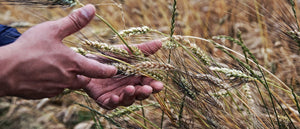The rotation of the land, a practice of vital importance to maintain the fertility of a land.
A very important practice to limit intervention on the land through fertilization techniques and the use of dedicated products, AMORETERRA adopts the technique of land rotation to avoid the use of any product that acts on the soil (not even those present in the organic disciplinary ).
 (Tuscan-Emilian Apennines, Senatore Cappelli cultivation, batch rotation, first year.)
(Tuscan-Emilian Apennines, Senatore Cappelli cultivation, batch rotation, first year.)
The term used by many is "The ground gets tired", in reality what happens to the soil is the weakening which exhausts the metabolites useful for cultivation, in addition to this the weakening also generates the theme "diseases" and "parasites".

(Tuscan-Emilian Apennines, Senatore Cappelli cultivation, batch rotation, according to year.)
The rotation of the land is a very old technique that dates back to the Middle Ages.
Why we use this technique:
- Fertility of the soil
- Favor the production
- Elimination the use of phytosanitary chemicals
- Reduction environmental pollution
These are the main groups involved in crop rotations:
- Renewal (at the end of the cycle they leave the soil with a better structure due to processing, eg corn, rapeseed);
- Improvers (mainly legumes, nitrogen-independent, eg alfalfa, clover ..);
- Depauperative (generally grasses)
- Refurbishment improvers: legumes, such as soy.
It is also possible to obtain further advantages from the distribution of the workload of the soil, this occurs through the introduction of lawn or fallow crops into the cycle.

(Tuscan-Emilian Apennines, Senatore Cappelli cultivation, batch rotation, third year.)
To conclude, AMORETERRA adopts land rotation to improve fertility and guarantee a better yield, both quantitative and qualitative, of the raw material.



1 comment
Buon giorno, riassumo tutto con una parola: siete ammirevoli!!